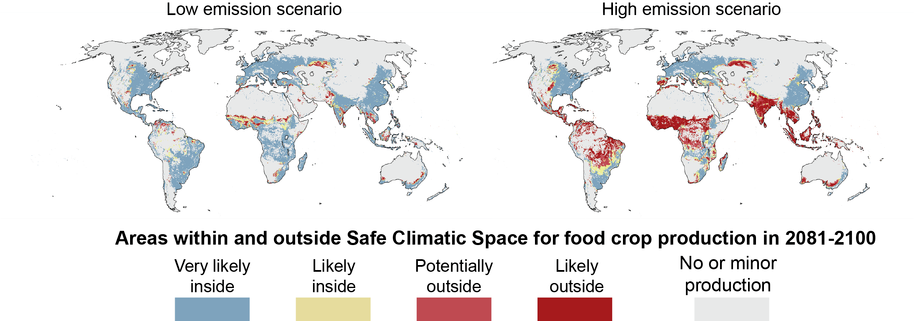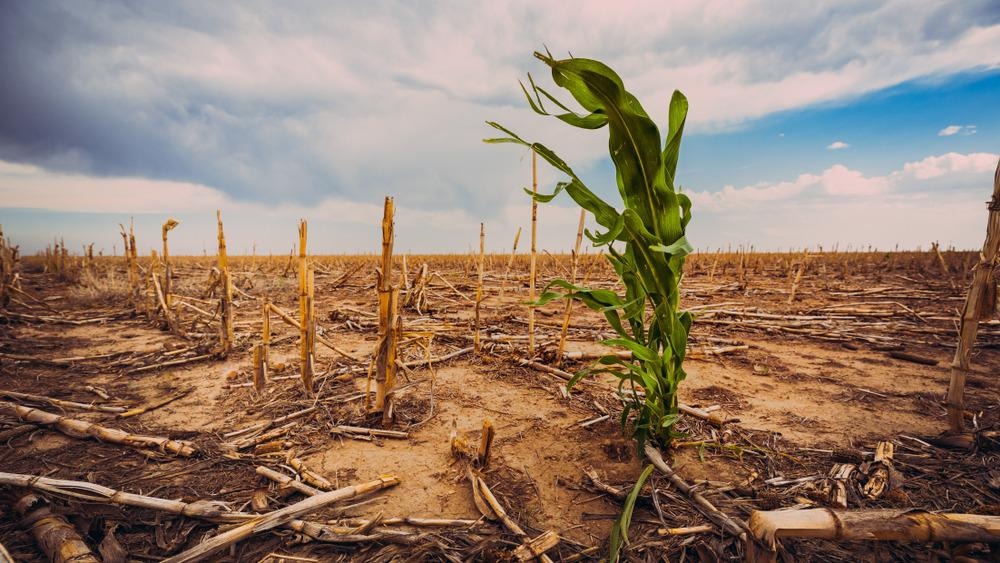May 17 2021
Climate change can adversely impact livestock and agriculture, but there is not much scientific understanding of the potential biggest risks and the areas of the planet that are likely to be affected.
 Areas within and outside Safe Climatic Space for food production 2081-2100. Image Credit: Matti Kummu/Aalto University.
Areas within and outside Safe Climatic Space for food production 2081-2100. Image Credit: Matti Kummu/Aalto University.
Now, a new study headed by Aalto University precisely examines how global food production will be impacted if greenhouse gas emissions are not reduced. The study was published in the leading journal One Earth on May 14th, 2021.
Our research shows that rapid, out-of-control growth of greenhouse gas emissions may, by the end of the century, lead to more than a third of current global food production falling into conditions in which no food is produced today—that is, out of safe climatic space.
Matti Kummu, Professor of Global Water and Food Issues, Aalto University
The study reported that this situation may probably take place if carbon dioxide emissions continue to increase at the present rate. In this analysis, the team defined the idea of safe climatic space as those regions in which 95% of crop production presently occurs due to a combination of three climate factors—that is, aridity, temperature, and rainfall.
The good news is that only a fraction of food production would face as-of-yet unseen conditions if we collectively reduce emissions, so that warming would be limited to 1.5 to 2 degrees Celsius.
Matti Kummu, Professor of Global Water and Food Issues, Aalto University
Variations in aridity and rainfall, as well as the warming climate, particularly pose a threat to food production in Southeast and South Asia and also the Sahel region of Africa. These are also regions that are unable to get used to the varying conditions.
Food production as we know it developed under a fairly stable climate, during a period of slow warming that followed the last ice age. The continuous growth of greenhouse gas emissions may create new conditions, and food crop and livestock production just won’t have enough time to adapt.
Matias Heino, Study Main Co-Author and Doctoral Candidate, Aalto University
The study used a couple of upcoming scenarios for climate change: one scenario where carbon dioxide emissions are drastically reduced, restricting global warming to 1.5 °C to 2 °C, and another scenario where emissions continue to increase relentlessly.
The team assessed how climate change would impact 27 of the most significant food crops and seven varied livestock, accounting for the varying capacities of societies to get used to changes.
The outcomes demonstrate that threats affect continents and nations in various ways. In 52 of the 177 nations analyzed, the whole food production would continue to stay in the safe climatic space in the days to come. These countries comprise Finland and a majority of other European nations.
Ghana, Benin, Guinea-Bissau, Cambodia, Suriname, and Guyana are already vulnerable nations and they will be affected considerably if changes are not made; up to 95% of present food production would fall beyond the safe climatic space.
Most disturbingly, these countries also have considerably less capacity to get used to variations caused by climate change when compared to rich Western nations. On the whole, 20% of the crop production in the world and 18% of livestock production facing threat are situated in nations that have low resilience to acclimatize to changes.
 Image Credit: Scott Book/Shutterstock.com
Image Credit: Scott Book/Shutterstock.com
If emissions of carbon dioxide are regulated, the team estimates that the boreal forest—the world’s biggest climatic zone of today that spans northern North America, Europe, and Russia—would reduce from its present 18.0 to 14.8 million km2 by 2100.
If these carbon dioxide emissions are not reduced, only about 8 million km2 of the huge forest would exist. In North America, the change would be even more significant—in 2000, the zone spanned around 6.7 million km2 but it may reduce to one-third by 2090.
Arctic tundra would be hit the hardest: this region is expected to vanish completely if climate change is not brought under control. In parallel, the tropical desert zones and the tropical dry forest are expected to grow.
“If we let emissions grow, the increase in desert areas is especially troubling because in these conditions barely anything can grow without irrigation. By the end of this century, we could see more than 4 million square kilometres of new desert around the globe,” added Kummu.
This analysis is the first to take a holistic approach toward the climatic conditions where food is currently grown and how climate change will impact these regions in the future, but its take-home message is certainly not special—the planet needs urgent action.
“We need to mitigate climate change and, at the same time, boost the resilience of our food systems and societies—we cannot leave the vulnerable behind. Food production must be sustainable,” concluded Heino.
Journal Reference:
Kummu, M., et al. (2021) Climate change risks pushing one-third of global food production outside the safe climatic space. One Earth. doi.org/10.1016/j.oneear.2021.04.017.